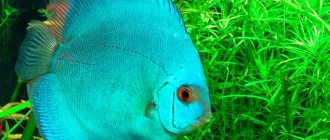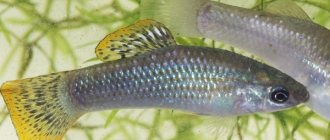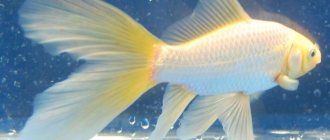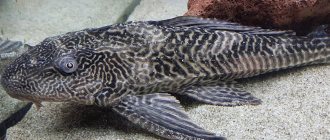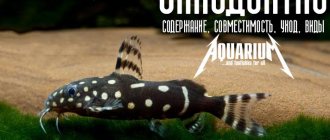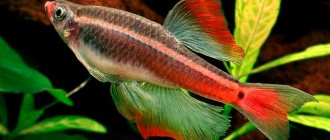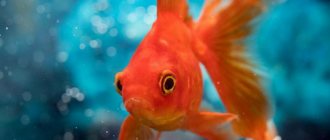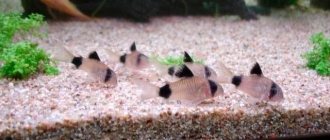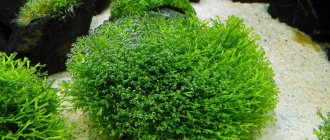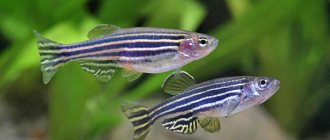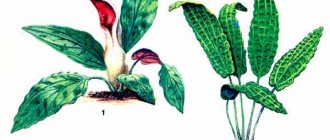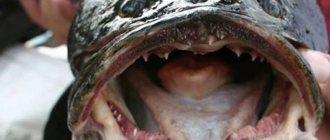Tetras are small, very colorful and agile fish that can create an atmosphere of harmony. Under natural conditions, they live mainly in the warm rivers of South America; they came to Europe in the second half of the 20th century because of their unique beauty. The appearance of the fish is very diverse; most often the tetra has a diamond-shaped or elongated body with colorless fins.
Types of tetras
The diversity of species may be the envy of other inhabitants of the aquarium. Let's look at the more common ones:
| View | Description |
| Tetra firefly (Hemigrammus erythrozonus) | It is gray-green in color, with red and orange stripes along the body that glow on both sides. The maximum length is 4 cm. The iris of the eyes is of two colors: red above and blue below. |
| Royal (Nematobrukon palmeri) | Adults - 6 cm, the color is pinkish-brown with a blue tint (sometimes purple), a rather wide black stripe is observed along the entire length, and has a unique tail with an elongated central ray. The iris of the eyes is blue. |
| Amanda's tetra (Hyphessobrycon amandae) | A very small species, never more than 2 cm, has a very rich reddish-orange (fiery) color. |
| Copper (Hasemania nana) | It grows up to 5 cm in length, the body is almost silver in color with a pronounced copper tint, a black line is visible at the beginning of the tail, and the ends of the unpaired fins are white. |
| Flashlight (Hemigrammus ocellifer) | Silver color, sides have a yellowish stripe. Dark-colored spots are located at the beginning of the caudal fin, as well as immediately behind the gills. The characteristic feature is the deep red color of the iris of the fish’s eyes (it “flashes” under certain lighting conditions). |
| Diamond (Moenkhausia pittieri) | The fish has a rather stocky appearance, and the body of the fish is flattened, no more than 6 cm. Special scales can reflect the light falling on them, turning them into small “diamonds”. A blue stripe begins in the middle of the tail, and the fins have an elongated appearance. |
| Rednose (Hemigrammus bleheri) | The size of adult fish is no more than 5 cm, usually silver in color with a greenish tint. The fins are transparent, and the tail has black and white stripes. A characteristic spot of a reddish hue on the head. |
| Congo (Phenacogrammus interruptus) | Adult specimens grow up to 8 cm in length, and females - up to 6 cm; their back and blue belly are characteristic, with a reddish-orange tint on the sides. They have an unusually shaped tail (with prominent central rays). |
Despite significant external differences in both body shape and fin structure, and a variety of colors, the differences between males and females within species are not clearly expressed. Only the African tetra has male fish that are more colorful and bright.
Aquarium Favorite
Home ponds contain a large number of freshwater fish. One of them belongs to the characidae family, and tetra is the common name for subspecies of this family. The fish “swimmed” into the domestic reservoirs of Europe from the rivers of South America in the 50s of the last century. They found it in warm, shallow rivers, the bottom of which is littered with snags, leaves and entangled with tree roots. This underwater landscape is comfortable for this baby.
Basic requirements for maintenance and care
Tetra does not require complex care, but for a regular school of 10 fish it is advisable to have at least 30-50 liters of water for the aquarium. It is better to release them at once in a small flock, since lonely individuals become aggressive, timid or inactive. It is better to cover the aquarium with a lid, because they are good jumpers.
Basic content rules:
- To maintain the parameters in the aquarium that are typical for living in natural conditions, the water must be settled and without chlorine.
- A rectangular shaped container is desirable because in round containers, sound reflects back from the walls, causing stress and negative effects.
- It is better to place the aquarium in a quiet corner, because the fish does not like noise and extreme activity around it.
- It is necessary to carry out aeration and replace twenty percent of the tank weekly.
- For soil, it is better to use river sand and dark, medium-sized pebbles (shells and stones can lead to an increase in the overall hardness of the water).
- To release the necessary tannins, it is better to place oak driftwood and alder leaves on the bottom.
- Fish loves not very bright, but slightly dim lighting.
- If fed correctly, the tetra will not eat water decorations, so you can safely decorate with the most expensive algae.
Tetras generally like to stay on the surface; they are almost not interested in the bottom area. But it is still important to provide them with secluded corners of driftwood and algae so that they can hide from bright light or aggressive neighbors. It is better to place such plantings on the back or side walls of the aquarium.
Before planting, plants should be soaked for 5-10 minutes in a salt solution: 1 teaspoon per liter of water to prevent the risk of introducing various parasites into the tank.
Content
Although Tetras have lived in the artificial environment of aquariums for many generations, they still require conditions that resemble their natural habitat. First of all, this relates to the hydrochemical composition of water. Successful long-term maintenance is only possible in slightly acidic water with a low level of carbonate hardness (dGH) containing a certain amount of dissolved tannins, in particular tannins. It is worth remembering that such an important parameter as lighting is noted - in bright light the color of the fish fades, but in dim light, on the contrary, it appears in all its glory. As for the design, the choice of decor is not so critical; fish can live quite comfortably even in a half-empty tank.
Our product Aqvium natural dry food for small and medium fish from clean lakes of Siberia and Northern Crimea in environmentally friendly biodegradable packaging.
Find out more
Basic feeding rules
This fish is undemanding in food. Loves both frozen food and live food, special granulated food. But brightness and color are preserved only with a varied and nutritious diet. True, live food if not completely eaten can cause water contamination, although it makes up a significant part of the diet. It can be:
- Daphnia;
- Artemia;
- bloodworm;
- Cyclops;
- tubifex;
- fruit flies.
They also eat dry granulated food (Wafer or Tetra mix). When using Discus granules, it is advisable to knead the granules with your hands.
It is advisable to periodically feed with bread crumbs or crushed oatmeal, being careful not to overfeed (they lead to obesity). They willingly eat chopped spinach or broccoli, egg yolk, have a good appetite and will not refuse any treat.
When selecting, it is important to give preference to feed that remains at the top for a long period of time and rather slowly sinks to the bottom. This is due to the peculiarities of their upward-turned mouthparts.
When feeding, you need to calculate that the entire amount of food is eaten in 3-5 minutes, before it has time to sink to the bottom: they will no longer eat from the bottom. It is enough to feed twice a day: morning and evening, varied and balanced.
The essence of the surname Tetra by letter
The surname Tetra consists of 5 letters. The five letters of the surname indicate humanitarian inclinations. These people love and appreciate art and are pleasant and interesting conversationalists. Such a person will never give his interlocutor the impression that he is dealing with an empty-headed person. That is why relationships with the opposite sex are always built, first of all, on mutual respect. By analyzing the meaning of each letter in the Tetra surname, you can understand its essence and hidden meaning.
- Creative, sensitive people; They have high intuition and are in constant search for truth. Often desires do not coincide with possibilities. They strive to do everything quickly, without putting it off until tomorrow. Demanding of others and themselves. The desire to search for truth. Reassessing your capabilities.
- Self-expression, desire to share experiences. Act as a mediator in conflicts. They are insightful and understand the world of secrets. Talkative. A strong love of travel, in life these people can often change their place of residence and are restless.
- Creative, sensitive people; They have high intuition and are in constant search for truth. Often desires do not coincide with possibilities. They strive to do everything quickly, without putting it off until tomorrow. Demanding of others and themselves. The desire to search for truth. Reassessing your capabilities.
- Resist external influence, self-confident, courageous, enthusiastic individuals. Capable of taking unjustified risks, adventurous natures prone to categorical judgments. The ability to take risks to achieve a goal. Readiness and potential for leadership.
- The strongest and brightest letter of the Cyrillic alphabet. People with these letters in their last names always strive for leadership. They often compete with themselves. Indicates a desire to change something, to achieve the highest level of comfort both physically and spiritually.
Features of reproduction
And there are no difficulties when breeding tetras. They reach sexual maturity at 6-11 months, depending on the species. The fish do not have a special time for spawning; they simply require preliminary intensive feeding for one week. The more active pair are deposited separately in a spawning tank with a capacity of 20-30 liters, with cleaner water and aeration.
The signal for the start of spawning will be a decrease in acidity and an increase in habitat temperature. At one time, the female brings several hundred eggs, after which she must sit down so that she does not eat the eggs. After a few hours, unfertilized eggs become whitish-cloudy and are removed. The tank is placed in a dark place (the eggs do not like sunlight), after 4-6 days the fry can be seen.
In the first days they will feed on the contents of their pouch. At first, hard-boiled egg yolks and ciliates are useful to them. In the first week, the fry need to be fed more frequently (every three hours), and then less frequently.
Until adulthood, the fry are kept separately. You need to feed finely ground food, live dust or plankton. They love the absence of aeration and perfectly clean water, oxygen saturation and frequent filtration. It is necessary to regularly remove the remaining food and dead larvae. In just two weeks, the fry become accustomed to living conditions similar to those of adults.
Coloring begins to appear towards the end of the first month. They have good survivability.
Breeding
Egg-laying Tetras reproduce quite easily in home aquariums. In the period from 4 to 12 months, individuals become sexually mature (depending on the variety). The first sign of a female’s readiness for mating games is her hiding in thickets of aquatic plants.
If there are 8-10 fish in a school, then, most often, Tetras independently form a pair, which is soon placed in the spawning area.
This tank is pre-prepared by placing Java mosses and a fine-mesh separator mesh on the bottom, filling it with warm water and installing weak filtration and aeration. For about a week, future parents are intensively fed with live food, then the water temperature is raised a couple of degrees and a significant portion of distilled water is added, softening it. Spawning usually occurs in the morning, with 150-200 eggs in the clutch. The parents are removed from the spawning tank; their scales may be cloudy for some time after spawning.
Those eggs that are fertilized are transparent; those that are not fertilized quickly become cloudy. Tetra clutches are very sensitive to fungus and other infections, so it is better to use an ultraviolet sterilizer in the spawning area and keep the lighting dim.
The water temperature is always maintained at +32 °C, and on the third or fourth day the fry will swim on their own.
Juveniles have a high mortality rate in the first days of life; Tetra is perhaps the slowest growing fish.
The first feeding is Artemia nauplius, live dust, ciliates. The fry are kept on such food for almost three months, then larger feeds are introduced.
The temperature should be maintained high until the fourth or even sixth month of life, not lower than +30 ° C, then the growth of the juveniles is slightly accelerated and the survival rate becomes higher.
Compatibility and character of fish
Tetras are suitable for keeping with almost all small tropical fish of the same size and temperament. They are considered peace-loving creatures. They love large groups, and isolation, on the contrary, shortens their life expectancy. They get along with non-aggressive species that can live in similar conditions.
| Compatible: | Incompatible: |
|
|
|
|
|
|
|
|
|
|
| |
| |
| |
| |
| |
|
Predators can take food and simply annoy you with their activity, while tetras can also arouse “gastronomic” interest.
Tetra Lifespan and Diseases
The lifespan is determined by several factors:
- required temperature, acidity, hardness;
- volume of the aquarium (personal space of each individual);
- weekly water changes;
- do not overfeed.
Tetras live in an aquarium for 5 - 6 years, but there are long-livers - up to 8 years.
The diseases of all aquarium fish are the same, and the same applies to Tetras. They get sick from:
- improper aeration;
- temperature, acidity, hardness;
- filtration;
- aquarium volumes;
- stress;
- when living with aggressive “neighbors”.
Due to improper maintenance, poisons appear: nitrites, nitrates, ammonia, which have a detrimental effect on the life and health of the inhabitants. Proper maintenance of the environment and cleanliness solve many problems with fish diseases.
Conclusion
Tetra is an unpretentious fish, the maintenance of which is not difficult; even an inexperienced aquarist can keep it. But for all its unpretentiousness, Tetra requires care. Only an attentive, sensitive, reverent approach can make aquarium inhabitants healthy and happy.
Sex differences
The distinctive features of the tetra are not obvious. Male individuals are often distinguished by more pronounced colors (although in unfavorable environments their colors become paler) and larger sizes. There are exceptions. For example, the male mirror tetra is smaller than the female, although it differs in the color of the anal fin (the male has a silver-white edge, while the female has white only at the tip). During spawning, the female can still be distinguished by her larger abdomen.
In the tetra minor, the male is also slimmer than the female, has a white stripe on the anal fin (while the female has only a small dot), and is more brightly colored.
Variety of species
As for the diversity of tetra fish, there are a lot of species. They are divided more by appearance than by behavior and temperament. Next are the most popular types with photos.
African
Scientifically, Arnoldichthys spilopterus lives in the Congo. This is an unusual, rainbow fish, shimmering in many bright shades - from purple to yellow. They have an elongated body and large scales.
White
Gymnocorymbus ternetzi, artificially bred from the Black Tetra. High body, large, veil fins, transparent color. Undemanding, perfect for a beginning breeder.
Diamond
Moenkhausia pittieri, found in Venezuela. It has an oval, slightly elongated body, yellowish-gray color. A distinctive feature of the breed is its scales, which can reflect and break light into rainbow reflections, like a diamond.
Blue
Alestopetersius smykalai, native to Nigeria. Almost disappeared in nature, its export is prohibited. Color - silver with a blue tint. The body is long, slightly compressed at the sides.
Green stripe
Iguanodectes spilurus, or Tetra Iguana. Found throughout the Amazon. It is large in size - up to 10 cm. A distinctive feature is a green stripe along the body.
Golden
Hemigrammus rodwayi, live in the Amazon, at the crossroads of salt and fresh waters. Famous for their characteristic golden color. At the same time, individuals raised in captivity lose this shade, becoming silver.
Exquisite
Scientific name: Hyphessobrycon bentosi, found in slow-flowing tributaries. Pink body, black markings on fins with white tips.
Colombian
Hyphessobrycon columbianus, lives in the Acandi River on the border between Panama and Colombia. The color is double - blue on the back turns into silver towards the belly.
Royal
Nematobrycon palmeri, native to northwestern Colombia. The coloring of the royal tetra is unusual - its transparent, purple-tinged back is intersected by a black stripe, turning into a dark-colored abdomen. The most popular of the entire group of tetras.
Red
Hyphessobrycon flammeus, found in eastern Brazil. Notable for the bright fiery tint of its scales. If the fish is stressed, the color may fade.
Lemon
Hyphessobrycon pulchripinnis, native to the Peruvian Amazon. It is distinguished by its lemon color, which is also an indicator of the condition of the individual. If the scales turn pale, the fish is unhealthy.
Blue
Mimagoniates microlepis, lives in southeastern waters of Brazil. They have pale blue scales. During the mating season they are capable of emitting sound signals with their swim bladder.
Tetra
It is also called Ordinary. Scientific name: Prionobrama filigera. It has a diamond-shaped body and an adipose fin behind the dorsal. Lives up to 6 years, lives in schools. Characterized by a calm and peaceful disposition.
Ulreya
Hemigrammus ulreyi, lives in Paraguay. Gray scales, longitudinal stripe of black and yellow color throughout the body.
Schultz
Name - Hyphessobrycon haraldschultzi, family Сharacins, habitat - Araguaia River. It is distinguished by its red hue and dwarf size.
Black (Veil)
Gymnocorymbus ternetzi, derived from the Black Tetra. Its peculiarity is its long, voluminous fins, the size of the fish itself. The color of the body and tail is silver, and the dorsal and anal fins are inky black.
Sex differences
Males of this breed are larger than females and are much brighter in color. Males have a black stripe running along the side of the ventral and anal fins. The female's tail is pink.
Basic diseases and prevention
There are no specific ailments for this type of aquarium fish; they are often associated with defects in their maintenance. They cannot tolerate excessive acidity of the environment, which is why they can develop alcoholism or even get acid shock. A change in the mineral composition of the water can cause stress in the fish and they become less active.
Transplanting to another aquarium can also change the tetra's behavior. Typical fish diseases may include:
- fin rot;
- dropsy;
- various fungal infections;
- tuberculosis;
- goggle-eyed.
It is better to remove individuals with typical signs of disease immediately.
The entry of harmful substances into the aquarium can cause poisoning. Restlessness, color changes, difficulty breathing, and decreased appetite may appear. By normalizing the balance, you will quickly achieve the disappearance of these symptoms. Infectious diseases (mouth or fin rot, ulcers) are treated with special medications based on phenoxyethanol.
The presence of many unique varieties and colors, peaceful nature, unpretentiousness in maintenance, and absence of problems during breeding make the tetra one of the most favorite species of inhabitants of home aquariums. The tetra will undoubtedly not only decorate your aquarium, but will also give many pleasant moments of peace and tranquility.
Range and habitat
The tetra's homeland is South America. The fish came to Europe from the countries where the Amazon flows.
This could not help but form a number of peculiarities in its keeping - the tetra is heat-loving, prefers to have secluded corners and snags in the aquarium under which it will hide.
It is necessary to take into account that these fish are schooling fish, they are more comfortable when their fellow tribesmen are nearby. Single representatives of the species are usually either too shy or overly aggressive, and as a result live very short lives.
